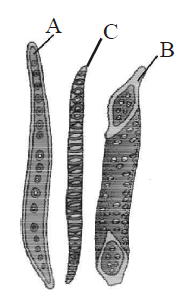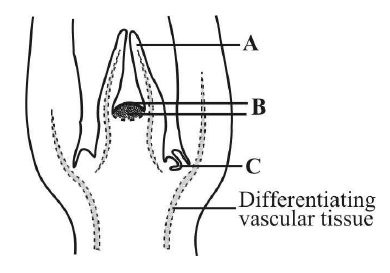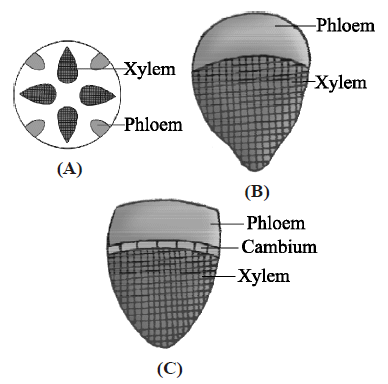Sclerenchyma usually___________and_____________ protoplasts.
live, without
dead, with
live, with
dead, without
Correct Answer :
D. dead, without
Sclerenchyma consists of long, narrow cells with thick and lignified cell walls having a few or numerous pits. They are usually dead and without protoplasts. They are simple dead mechanical tissue occuring in mature organs of plants body. They are chiefly distributed in cortex, pericyele, xylem and phloem region.
Related Questions
Match the followings and choose the correct option
| Column-I | Column-II |
|---|---|
| A. Cuticle | I. Guard cells |
| B. Bulliform cells | II. Outer layer |
| C. Stomata | III. Waxy layer |
| D. Epidermis | IV. Empty colourless cell |
A III, B IV, C I, D II
A I, B II, C III, D IV
A III, B II, C IV, D I
A III, B II, C I, D IV
In land plants, the guard cells differ from other epidermal cells in having
cytoskeleton.
mitochondria.
endoplasmic reticulum.
chloroplasts.
Choose the correct labelling of (A J) in the given figure of T.S. of monocot root.

A Root hair, B Epiblema, C Cortex, D Endodermis, E Passage cell, F Pericycle, G Pith, H Phloem, I Metaxylem.
A Root hair, B Epiblema, C Cortex, D Endodermis, E Passage cell, F Pith, G Pericycle, H Metaxylem, I Phloem.
A Root hair, B Epiblema, C Cortex, D Endodermis, E Pericycle, F Phloem, G Protoxylem, I Metaxylem
A Root hair, B Cortex, C Epiblema, D Pericycle, E Endodermis, F Pith, G Phloem, H Protoxylem, I Metaxylem
Cork cambium and vascular cambium are
the parts of secondary xylem and phloem.
the parts of pericycle.
lateral meristems.
apical meristems.
Which of the following pair of match is not correct?
Pith - Large and well developed in monocotyledonous root.
Root hairs - Helps in preventing water loss due to transpiration
Sieve tube elements - Its functions are controlled by the nucleus of companion cells.
Stomatal apparatus - Consists of stomatal aperture, guard cells and surrounding subsidiary cells
T.S. of dicot leaf passing through the midrib is given below. Certain parts have been marked by alphabets (A to H). Choose the option showing their correct labelling.

A Epidermis, B Spongy mesophyll, C Palisade mesophyll, D Stomata, E Guard cells, F Phloem, G Metaxylem, H Protoxylem
A Epidermis, B Palisade mesophyll, C Spongy mesophyll, D Sub-stomatal cavity, E Stoma, F Phloem, G Xylem, H Bundle sheath
A Epidermis, B Palisade mesophyll, C Spongy mesophyll, D Stomata, E Guard cells, F Epidermis, G Xylem, H Phloem
A Epidermis, C Palisade mesophyll, C Spongy mesophyll, D Stomata, E Guard cells, F Phloem, G Metaxylem, H Protoxylem
A piece of wood having no vessels (trachea) must be belonged to
teak
mango
pine
palm
Sclerenchyma usually___________and_____________ protoplasts.
live, without
dead, with
live, with
dead, without
Main function of lenticel is
transpiration
guttation
gaseous exchange
both (a) & (c)
Which of following helps bamboo and grasses to elongate ?
Apical meristems
Lateral meristems
Secondary meristems
Intercalary meristems
The length of different internodes in a culm of sugarcane is variable because of
size of leaf lamina at the node below each internode
intercalary meristem
shoot apical meristem
position of axillary buds
In stems, the protoxylem lies towards the _____________ and the metaxylem lies towards the ____________ of the organ.
centre; periphery
periphery; centre
periphery; periphery
centre; centre
The given figures are types of elements (A and B) which constitute one type of complex tissue (c) of a plant . Identify A, B and C.

A Tracheid, B Vessel, C Xylem
A Vessel, B Tracheild, C Phloem
A Fibre, B Tracheid, C Bark
A Fibre, B Sclereid, C Casparian strips
Sieve tubes are suited for translocation of food because they possess
bordered pits.
no ends walls.
broader lumen and perforated cross walls.
no protoplasm.
Identify A, B and C in the given figure of shoot apical meristem

A Leaf primordium, B Shoot apical meristem, C Axillary bud
A Leaf primordium, B Shoot apical meristem, C Apical bud
A Root hair primordium, B Root apical meristem, C Axillary bud
A Root hair primordium, B Root apical meristem, C Terminal bud
A narrow layer of thin walled cells found between phloem/ bark and wood of a dicot is
cork cambium
vascular cambium
endodermis
both (a) & (c)
As secondary growth proceeds, in a dicot stem, the thickness of
sapwood increases.
heartwood increase.
both sapwood and heartwood increases.
both sapwood and heartwood remains the same.
Identify types of vascular bundles in given figures A, B and C.

Radial; Conjoint closed; Conjoint open
Conjoint closed; Conjoint open; Radial
Conjoint open; Conjoint closed; Radial
Bicollateral; Concentric; Radial
Apical, intercalary and lateral meristems are differentiated on the basis of
origin
function
position
development
Match the elements of xylem given in column I with their character given in the column II and choose the correct option.
| Column-I | Column-II |
|---|---|
| A. Xylem vessels | I. Store food materials |
| B. Xylem tracheids | II. Obliterated lumen |
| C. Xylem fibres | III. Perforated plates |
| D. Xylem parenchyma | IV. Chisel-like ends |
A IV; B III; C II; D I
A III; B II; C I; D IV
A II; B I; C IV; D III
A III; B IV; C II; D I
A plant tissue when stained showed the presence of hemicellulose and pectin in cells wall of its cells. The tissue is called
collenchyma
sclerenchyma
xylem
meristem
Trees at sea do not have annual rings because
soil is sandy.
there is climatic variation.
there is no marked climatic variation.
there is enough moisture in the atmosphere.
Tissues are classified into two main groups, namely meristematic and permanent tissues on the basis of
whether the cells being able to divide or not.
position of the cells.
whether they are living or dead.
none of the above
Phellogen and phellem respectively denote
cork and cork cambium,
cork cambium and cork,
secondary cortex and cork,
cork and secondary cortex,
A tissue is a group of cells which are
similar in origin, but dissimilar in form and function.
dissimilar in origin, form and function.
dissimilar in origin, but similar in form and function.
similar in origin, form and function.
Cells of permanent tissues are specialized
functionally.
only structurally.
both structurally and functionally.
for mitosis.
Which one of the following have vessels as their characteristic feature?
Angiosperms
Gymnosperms
Pteridophytes
Bryophytes
Which of the following are present in monocot root ?
conjoint, collateral, open polyarch vascular bundle.
exodermis, endarch, tetrarch closed vascular bundles.
suberized exodermis, casparian strip, passage cells, cambium.
suberized exodermis, polyarch xylem, pith.
Lignin is the important constituent in the cell wall of
phloem
parenchyma
xylem
cambium
Gymnosperms are also called soft wood spermatophytes because they lack
cambium
phloem fibres
thick-walled tracheids
xylem fibres
